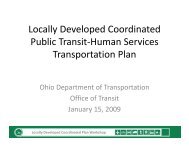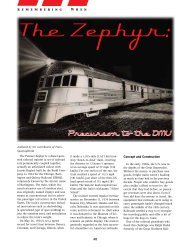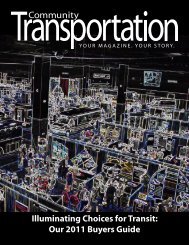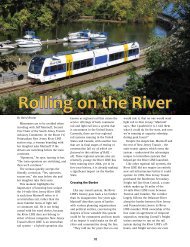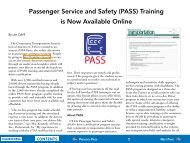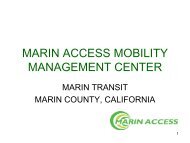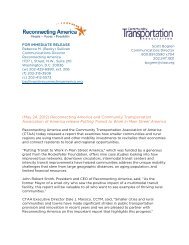San Luis Obispo - Caltrans - State of California
San Luis Obispo - Caltrans - State of California
San Luis Obispo - Caltrans - State of California
You also want an ePaper? Increase the reach of your titles
YUMPU automatically turns print PDFs into web optimized ePapers that Google loves.
SAN LUIS OBISPO REGION<br />
COORDINATED HUMAN SERVICES-PUBLIC TRANSPORTATION PLAN<br />
broadest caseload representation was among generalized groups where agencies were serving<br />
multiple consumer groups -- senior and disabled social services and public social services<br />
agencies, together reporting over 105,000 consumers. Specifically low income consumers were<br />
reported as 1637. Agencies serving youth and children reported 1300 consumers. Medical<br />
and health-related agencies responding reported 1080 consumers. Public transit agencies,<br />
presumably reporting the registered users on dial-a-ride and demand response services,<br />
reported 920 consumers.<br />
Table 3-4- 2007 Stakeholder Survey<br />
Caseload/ Constituencies Reported by Service Type<br />
n <strong>of</strong><br />
Agencies<br />
Reported<br />
Caseload<br />
% <strong>of</strong> Total<br />
Caseload<br />
Consumer Groups Served<br />
Senior/ Disabled, Social Services 23 53,023 48%<br />
General Public, Social Services 11 52,548 47%<br />
Low Income 5 1,637 1%<br />
Youth/ Child 2 1,300 1%<br />
Medical/Health 4 1,080 1%<br />
Public Transit Agencies 7 920 1%<br />
Faith Based 1 175 0%<br />
Education 6 119 0%<br />
Commercial Operators 2 0 0%<br />
Totals 61 110,802 100%<br />
As noted previously, these numbers may include some level <strong>of</strong> duplication. But they also<br />
represent different communities <strong>of</strong> interest that are suggested by their responding agencies.<br />
The varying types <strong>of</strong> consumers these agencies represent are worth noting.<br />
Transportation Services Provided<br />
Agencies were asked to describe the transportation they may provide and <strong>of</strong>fered a number <strong>of</strong><br />
ways in which to characterize that service. Responses could include:<br />
• Arranging for transportation by assisting with information but clients responsible for<br />
follow-up<br />
• Subsidizing transportation through agency purchase <strong>of</strong> coupons, scrip, passes, fares or<br />
mileage reimbursement<br />
• Agency directly operates transportation with full responsibility for the transportation by<br />
this agency<br />
• Arranging for volunteer drivers<br />
• Public transit provision to general public<br />
• Contracting with another entity or agencies to provide transportation services<br />
• No transportation operated, contracted or subsidized<br />
Figure 3-3 presents the results for the data set as a whole, identifying separately those entities<br />
that provide public transportation services. For purposes <strong>of</strong> this analysis, the Ride-On CTSA<br />
program has been included in that group. Figure 3-3 presents the forms <strong>of</strong> transportation<br />
reported by responding agencies. Providing no form <strong>of</strong> transportation was selected by onethird<br />
<strong>of</strong> all respondents (21 agencies-34 percent). These agencies are neither directly providing<br />
transportation nor assisting consumers in obtaining transportation services. By contrast, almost<br />
one-quarter (14 agencies-23 percent) are at a minimum arranging transportation for<br />
consumers in a variety <strong>of</strong> ways. This can mean simply providing phone numbers and letting<br />
consumers request their own trips. Or, it may be more involved with staffers making the trip<br />
29<br />
OCTOBER 2007



